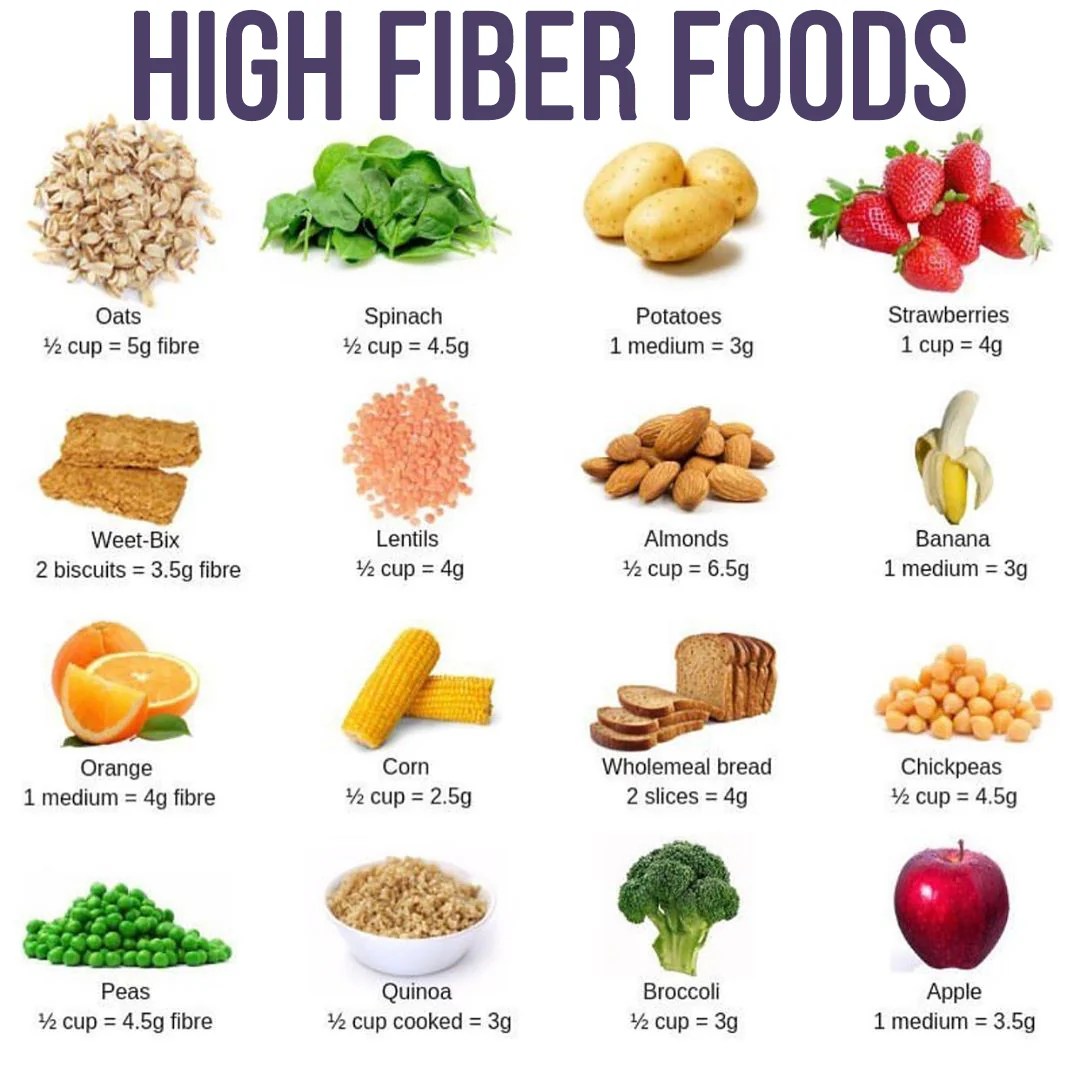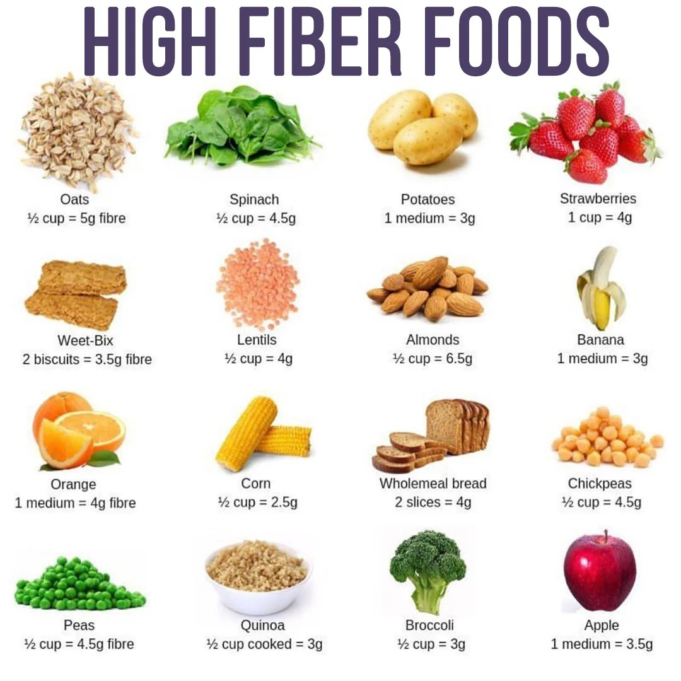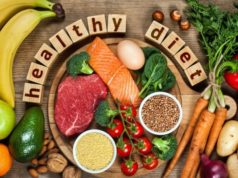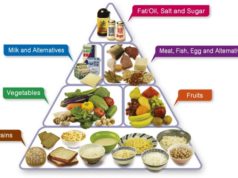Ways to add fiber to diet – Ways to add fiber to your diet are essential for maintaining a healthy digestive system and overall well-being. Fiber, a type of carbohydrate that the body cannot digest, plays a crucial role in regulating bowel movements, promoting satiety, and managing blood sugar levels. This article will delve into the various ways to incorporate fiber into your daily routine, from understanding the different types of fiber to exploring practical tips and delicious recipes.
We’ll discuss the recommended daily intake of fiber, the health benefits of consuming adequate amounts, and the potential risks associated with insufficient fiber intake. Additionally, we’ll provide a comprehensive list of fiber-rich foods categorized by food groups, including fruits, vegetables, grains, legumes, nuts, and seeds. This information will empower you to make informed choices about incorporating fiber into your diet.
Understanding Fiber
Fiber is an essential nutrient that plays a crucial role in maintaining good health. It’s a type of carbohydrate that the human body can’t digest, but it’s still vital for various bodily functions.
Types of Dietary Fiber
Dietary fiber is categorized into two main types: soluble and insoluble.
- Soluble fiber dissolves in water and forms a gel-like substance in the digestive tract. This type of fiber helps regulate blood sugar levels, lower cholesterol, and promote a feeling of fullness.
- Insoluble fiber doesn’t dissolve in water and adds bulk to the stool. It helps promote regular bowel movements and prevent constipation.
Benefits of Fiber
Fiber offers numerous health benefits, including:
- Improved Digestive Health: Fiber adds bulk to stool, aiding in regular bowel movements and preventing constipation. It also promotes the growth of beneficial bacteria in the gut, contributing to a healthy digestive system.
- Weight Management: Fiber helps you feel full, which can prevent overeating and aid in weight management. It also slows down the absorption of sugar into the bloodstream, preventing blood sugar spikes and crashes.
- Heart Health: Soluble fiber helps lower cholesterol levels, reducing the risk of heart disease. It also helps regulate blood pressure.
- Blood Sugar Control: Soluble fiber slows down the absorption of sugar into the bloodstream, helping to regulate blood sugar levels and prevent diabetes.
- Reduced Risk of Certain Cancers: Some studies suggest that a high-fiber diet may lower the risk of certain cancers, including colon cancer.
Recommended Daily Intake of Fiber, Ways to add fiber to diet
The recommended daily intake of fiber for adults is 25 grams for women and 38 grams for men. However, most people don’t consume enough fiber.
Health Risks of Insufficient Fiber Intake
A lack of fiber in the diet can lead to various health problems, including:
- Constipation: This is the most common symptom of low fiber intake. Insufficient fiber can make it difficult to pass stool regularly, leading to discomfort and bloating.
- Diverticulosis: This condition involves small pouches forming in the lining of the colon. It can be caused by low fiber intake, which can weaken the colon walls.
- Heart Disease: Low fiber intake can lead to high cholesterol levels, increasing the risk of heart disease.
- Diabetes: Insufficient fiber can contribute to uncontrolled blood sugar levels, increasing the risk of type 2 diabetes.
- Colon Cancer: Some studies suggest that a low-fiber diet may increase the risk of colon cancer.
Fiber-Rich Recipes: Ways To Add Fiber To Diet
Including fiber-rich foods in your diet is essential for maintaining good digestive health and overall well-being. By incorporating these recipes into your meal plan, you can enjoy delicious and nutritious dishes while increasing your fiber intake.
Fiber-Rich Recipes
Here are a few delicious and fiber-rich recipes that you can easily incorporate into your diet:
Black Bean Burgers
Black beans are an excellent source of fiber and protein, making them an ideal ingredient for veggie burgers. These burgers are flavorful, hearty, and perfect for a quick and healthy meal.
- Ingredients:
- 1 (15-ounce) can black beans, rinsed and drained
- 1/2 cup rolled oats
- 1/4 cup chopped onion
- 1/4 cup chopped cilantro
- 1 tablespoon chili powder
- 1 teaspoon cumin
- 1/2 teaspoon garlic powder
- 1/4 teaspoon salt
- 1/4 teaspoon black pepper
- 1 tablespoon olive oil
- Instructions:
- In a food processor, combine all ingredients except olive oil and pulse until well combined but still slightly chunky.
- Form the mixture into 4 patties.
- Heat olive oil in a large skillet over medium heat. Cook patties for 5-7 minutes per side, or until golden brown and cooked through.
- Serve on buns with your favorite toppings.
- Nutritional Information (per burger):
- Calories: 250
- Protein: 15 grams
- Carbohydrates: 35 grams
- Fiber: 10 grams
Quinoa Salad with Roasted Vegetables
Quinoa is a complete protein and a good source of fiber, making it a healthy and satisfying base for a salad. Roasted vegetables add flavor and nutrients to this dish.
- Ingredients:
- 1 cup quinoa, rinsed
- 2 cups water
- 1 cup broccoli florets
- 1 cup Brussels sprouts, halved
- 1 red bell pepper, chopped
- 1 yellow bell pepper, chopped
- 1 tablespoon olive oil
- 1/2 teaspoon salt
- 1/4 teaspoon black pepper
- 1/4 cup chopped fresh parsley
- 1/4 cup lemon juice
- Instructions:
- Preheat oven to 400 degrees F (200 degrees C).
- In a large pot, combine quinoa and water. Bring to a boil, then reduce heat to low, cover, and simmer for 15 minutes, or until quinoa is cooked through and water is absorbed.
- While quinoa is cooking, toss broccoli, Brussels sprouts, red bell pepper, and yellow bell pepper with olive oil, salt, and pepper on a baking sheet. Roast for 20-25 minutes, or until vegetables are tender and slightly browned.
- Once quinoa is cooked, fluff with a fork and let cool slightly. Combine quinoa with roasted vegetables, parsley, and lemon juice.
- Serve warm or cold.
- Nutritional Information (per serving):
- Calories: 350
- Protein: 10 grams
- Carbohydrates: 50 grams
- Fiber: 12 grams
Oatmeal with Berries and Nuts
Oatmeal is a classic breakfast option that is high in fiber and can help you feel full and satisfied. Adding berries and nuts provides additional nutrients and flavor.
- Ingredients:
- 1/2 cup rolled oats
- 1 cup water
- 1/4 cup berries (such as blueberries, raspberries, or strawberries)
- 1/4 cup chopped nuts (such as almonds, walnuts, or pecans)
- 1 tablespoon chia seeds
- 1/4 teaspoon cinnamon
- 1/4 teaspoon vanilla extract
- Instructions:
- In a small saucepan, combine oats, water, berries, nuts, chia seeds, cinnamon, and vanilla extract.
- Bring to a boil, then reduce heat to low, cover, and simmer for 5 minutes, or until oatmeal is cooked through.
- Serve warm.
- Nutritional Information (per serving):
- Calories: 300
- Protein: 10 grams
- Carbohydrates: 45 grams
- Fiber: 10 grams
Lentil Soup
Lentils are a great source of fiber and protein, making them a filling and satisfying soup option. This recipe is simple to make and can be customized with your favorite vegetables.
- Ingredients:
- 1 cup lentils, rinsed
- 4 cups vegetable broth
- 1 onion, chopped
- 2 carrots, chopped
- 2 celery stalks, chopped
- 2 cloves garlic, minced
- 1 teaspoon dried thyme
- 1/2 teaspoon salt
- 1/4 teaspoon black pepper
- Instructions:
- In a large pot or Dutch oven, combine lentils, vegetable broth, onion, carrots, celery, garlic, thyme, salt, and pepper.
- Bring to a boil, then reduce heat to low, cover, and simmer for 30-40 minutes, or until lentils are tender.
- Serve warm with a dollop of yogurt or sour cream.
- Nutritional Information (per serving):
- Calories: 200
- Protein: 15 grams
- Carbohydrates: 30 grams
- Fiber: 15 grams
Chia Seed Pudding
Chia seeds are a great source of fiber and omega-3 fatty acids. This pudding is a healthy and refreshing dessert or breakfast option.
- Ingredients:
- 1/4 cup chia seeds
- 1 cup almond milk
- 1/4 cup berries (such as blueberries, raspberries, or strawberries)
- 1 tablespoon maple syrup
- 1/4 teaspoon vanilla extract
- Instructions:
- In a jar or bowl, combine chia seeds, almond milk, berries, maple syrup, and vanilla extract.
- Stir well and refrigerate for at least 4 hours, or overnight.
- Serve cold.
- Nutritional Information (per serving):
- Calories: 200
- Protein: 5 grams
- Carbohydrates: 30 grams
- Fiber: 10 grams
Fiber Supplements
Fiber supplements can be a convenient way to increase your fiber intake if you struggle to get enough through diet alone. They come in various forms, each with its own benefits and potential drawbacks.
Types of Fiber Supplements
Fiber supplements are available in various forms, each containing different types of fiber.
- Psyllium husk: A soluble fiber derived from the husks of the psyllium plant, often used in laxatives and to lower cholesterol levels.
- Methylcellulose: A soluble fiber derived from cellulose, commonly found in over-the-counter medications for constipation.
- Wheat dextrin: A soluble fiber derived from wheat, often used in weight management products.
- Inulin: A soluble fiber naturally found in some fruits and vegetables, frequently used as a prebiotic to promote gut health.
- Polydextrose: A soluble fiber often used as a bulking agent in food products.
Benefits of Fiber Supplements
Fiber supplements offer various potential benefits for your health, including:
- Regular bowel movements: Fiber adds bulk to stool, making it easier to pass and preventing constipation.
- Lowering cholesterol: Some soluble fibers can bind to cholesterol in the gut, helping to reduce its absorption and lower blood cholesterol levels.
- Blood sugar control: Soluble fiber can slow down the absorption of sugar from the gut, helping to regulate blood sugar levels.
- Weight management: Fiber can make you feel fuller for longer, potentially aiding in weight loss or management.
Potential Drawbacks of Fiber Supplements
While fiber supplements can be beneficial, they can also cause some side effects, especially when taken in high doses or without enough water:
- Gas and bloating: As your body adjusts to increased fiber intake, you may experience gas and bloating, especially when starting a new supplement.
- Diarrhea: Taking too much fiber, particularly soluble fiber, can lead to diarrhea.
- Dehydration: Fiber absorbs water in the gut, so it’s crucial to drink plenty of fluids when taking fiber supplements.
- Nutrient absorption interference: In some cases, fiber supplements can interfere with the absorption of certain nutrients.
Choosing and Using Fiber Supplements
- Start slowly: Begin with a small dose and gradually increase it as your body adjusts. This helps minimize digestive discomfort.
- Drink plenty of water: Ensure you drink plenty of water throughout the day, especially when taking fiber supplements. This helps prevent constipation and other side effects.
- Choose a supplement based on your needs: Different types of fiber have different benefits, so choose one that aligns with your specific health goals.
- Talk to your doctor: If you have any underlying health conditions or are taking medications, consult your doctor before starting fiber supplements.
Importance of Hydration

Increasing your fiber intake is a great way to improve your digestive health and overall well-being, but it’s important to remember that fiber needs water to work its magic. Think of fiber like a sponge; it absorbs water as it travels through your digestive system. Without enough fluids, fiber can become bulky and difficult to pass, leading to constipation and discomfort.
Water Intake Recommendations
When you increase your fiber intake, it’s essential to increase your water intake as well. This ensures that your body has enough fluids to help the fiber move through your digestive system smoothly. Here are some general recommendations for daily water intake:
- For men: 15.5 cups (3.7 liters) per day
- For women: 11.5 cups (2.7 liters) per day
These recommendations may vary depending on factors such as activity level, climate, and overall health. It’s always best to consult with a healthcare professional to determine the appropriate water intake for you.
Tips for Staying Hydrated
Staying hydrated throughout the day is crucial, especially when you’re increasing your fiber intake. Here are some tips to help you make sure you’re getting enough fluids:
- Keep a reusable water bottle with you and refill it throughout the day.
- Drink water before, during, and after meals.
- Choose water over sugary drinks like soda and juice.
- Eat fruits and vegetables that are high in water content, such as watermelon, cucumber, and spinach.
Final Conclusion
By incorporating these strategies into your lifestyle, you can effortlessly increase your fiber intake and reap the numerous health benefits it offers. Remember, a balanced diet rich in fiber is a key component of a healthy and fulfilling life. Embrace the power of fiber and experience the positive impact it can have on your overall well-being.
Clarifying Questions
What are the best sources of soluble fiber?
Soluble fiber dissolves in water and forms a gel-like substance in the gut. Good sources include oats, beans, lentils, apples, and berries.
How much fiber should I aim for each day?
The recommended daily intake of fiber for adults is 25 grams for women and 38 grams for men. However, it’s essential to consult with a healthcare professional to determine the appropriate amount for your individual needs.
What are some tips for preventing gas and bloating when increasing fiber intake?
Gradually increase your fiber intake over several weeks to allow your digestive system to adjust. Drink plenty of water, eat fiber-rich foods with meals, and choose whole grains over refined grains.
Adding fiber to your diet is crucial for digestive health and overall well-being. Incorporating whole grains, fruits, vegetables, and legumes can significantly increase your fiber intake. While a balanced diet with plenty of fiber is important, understanding what constitutes the “best diet” for overall health can be a bit more nuanced.
For a deeper dive into this topic, check out this informative article on what is the best diet for overall health. Regardless of your dietary choices, ensuring adequate fiber intake remains a cornerstone of a healthy lifestyle.
Adding fiber to your diet is a common recommendation for digestive health, but it’s important to do it gradually to avoid bloating or discomfort. If you’re struggling with Irritable Bowel Syndrome (IBS), understanding the best dietary approach is crucial.
You can find valuable information on the topic of Whats the Best Diet for Irritable Bowel Syndrome? and then tailor your fiber intake based on your individual needs and sensitivities. Whether you choose to focus on soluble or insoluble fiber, finding the right balance is key to achieving a healthy digestive system.
























